|
|
Post by bixaorellana on Oct 11, 2019 2:13:29 GMT
One of my goals in visiting Genoa this year was to visit its renowned cemetery, which broods in overwrought splendor on a hillside north of the city. Begun in 1840 and completed in 1881, it covers an area of more than a square kilometer. The day chosen for this excursion was dark and misty, with intermittent rain. What better day to commune with the dead and their loving commemorative monuments?  |
|
|
|
Post by bixaorellana on Oct 11, 2019 2:54:56 GMT
Outside now with the less fancy folk. Yes, it was as deserted as you see in the pictures. I doubt I saw even ten live humans walking around the whole time I was there. When I climbed higher up, though, I did see a couple of mini buses, either from private tours or as one source reports, a service of the cemetery. |
|
|
|
Post by bjd on Oct 11, 2019 5:29:25 GMT
So glad you got there! That was an unexpected highlight of our trip to Genoa many years ago. I do realize that it is a cemetery, but some of those statues are so over the top in kitsch that they are impossible to take seriously. I remember the outside as being more exciting than what you show though.
|
|
|
|
Post by questa on Oct 11, 2019 7:00:46 GMT
I guess there were interfamilial competitions to see who could get the most angels on the head of the dearly beloved. The sculptors and name carvers would have made a good living.
Bixa, when I first joined up here I posted a series of pics from the cemetery of St Petersburg showing the graves of the famous musicians and some glorious kitsch graves.I have never been able to find it again.Can you help me, please?
|
|
|
|
Post by fumobici on Oct 11, 2019 9:12:28 GMT
Thank you for stepping in where I didn't chronicle in my Genova report. The photos are umm atmospheric, and about in line with what I had expected to see there. The statuary is workmanlike, and sometimes better, but the pathos often comes across as maudlin to me. As bjd says, "hard to take seriously". There must have been a lot of wealthy 19th century Genovan families to underwrite this. It was either this cemetary or the funicular up to Righi for me that day, I'm glad we took different directions. Hope there is more to come here, I'm told there a lot of maudlin to take in at Stalgieno.
|
|
|
|
Post by kerouac2 on Oct 11, 2019 14:38:28 GMT
The cemetery mall looks like a lot of fun. Outdoors is much more normal, but it is interesting to see that grassy space is left between the tombs, completely different from France where the graves are all up against each other, even in small villages. The Italian style makes for some very complicated grass tending.
The angels are quite menacing, in my opinion.
|
|
|
|
Post by bixaorellana on Oct 11, 2019 17:36:55 GMT
I guess there were interfamilial competitions to see who could get the most angels on the head of the dearly beloved. Ha ~ good one, Questa! re: your query -- Nothing is occurring to me off the top of my head, but start by checking out Cemeteries in the Landmarks board, In Port category. ... the pathos often comes across as maudlin to me. As bjd says, "hard to take seriously". There must have been a lot of wealthy 19th century Genovan families to underwrite this. It was either this cemetary or the funicular up to Righi for me that day, I'm glad we took different directions. Hope there is more to come here, I'm told there a lot of maudlin to take in at Stalgieno. Ditto on being happy about the different directions! I'm still kicking myself for not getting around to the funicular, another reason to return to Genoa. And yes, there is lots and lots more to this, plus I'll provide links at the end of the thread for those who simply can't get enough. The angels are quite menacing, in my opinion. Yes, indeed. I believe some of them are supposed to represent death, often death-as-lover. Yeek. So glad you got there! That was an unexpected highlight of our trip to Genoa many years ago. I do realize that it is a cemetery, but some of those statues are so over the top in kitsch that they are impossible to take seriously. I remember the outside as being more exciting than what you show though. That had to have been a thrill. Was it kept less dusty back then? Re: exciting outside ~ As I said above, it was raining when I scuttled into the entrance, though I probably had plans to snap it later. When it was time to go, I was alarmed to find the gates where I entered securely closed and locked. I exited somewhere on the left after asking a lady directions in my non-existent Italian. My pidgin "Dove uscita?" was met with pidgin English directions. Here is a picture of the cemetery in glorious rotogravure ~
|
|
|
|
Post by fumobici on Oct 11, 2019 18:15:49 GMT
No, this is lovely. I want to go back and see it myself. Maybe in the fog? But not too much fog.
"Dove uscita" is fine. Any Italian would of course understand. Just changing it to "Dov'é l'uscita" makes it correct and those two doves are pronounced almost identically.
|
|
|
|
Post by bixaorellana on Oct 11, 2019 18:37:50 GMT
You are the veritable dove of kindness and helpfulness, Fumobici ~ thank you! There will be fog in this report, but not too much fog. |
|
|
|
Post by bixaorellana on Oct 11, 2019 18:44:55 GMT
|
|
|
|
Post by kerouac2 on Oct 11, 2019 19:09:12 GMT
Artists have the strangest ideas about portraying death and mourning although I'm sure that in many cases they were just trying to illustrate that for which their bereaved clients had asked. The threesome in one of the photos above leaves me totally perplexed nevertheless.
|
|
|
|
Post by lagatta on Oct 11, 2019 22:22:56 GMT
One would think that nowadays there are vacuum cleaners capable of delicate work such as removing the dust without damaging the statuary.
|
|
|
|
Post by bixaorellana on Oct 11, 2019 22:45:26 GMT
Kerouac, those are the three graces rendered in early Art Deco style. I know this because I have a stash of links which I will visit upon you all at the end of this report, i.e., after I force everyone to look at my pictures. My attraction to cemeteries began in my hometown, which has a particularly atmospheric one which is a combination of Southern Gothic and Victorian. There are many small children and babies buried there from generations before I was born. Nevertheless, reading the inscriptions on those small gravestones can leave me in floods of tears. In contrast to that, the monumentally sentimental memorials in Staglieno left me unmoved. That was, until I got to this section, which had me brokenly leaving off picture-taking to hurry away from it as I furiously wiped my eyes and blew my nose ~ |
|
|
|
Post by bixaorellana on Oct 12, 2019 17:43:53 GMT
LaGatta, one would think that a regular vacuum cleaner or super strong dust buster set to reverse would help a great deal. Think those sculptures can't be all that delicate. I guess it's a situation of being able to hire enough people to blow through the giant place at least bi-monthly. |
|
|
|
Post by kerouac2 on Oct 12, 2019 20:43:10 GMT
I wouldn't use a vacuum cleaner. I would use a Kärcher.
As delightful as all of these tombs are, I find myself suddenly wanting to see an atheist/anarchist cemetery. But of course such a thing could never exist. I'm sure they scatter all of their ashes or dump them into the municipal water system.
|
|
|
|
Post by bixaorellana on Oct 13, 2019 4:22:16 GMT
Ah yes ~ the damn the torpedoes school of tomb washing. Actually, you are wrong about the deceased atheists/anarchists. For one thing, they have families who choose to inter them in the conventional ways, plus anarchists or not, there are laws about disposing of human remains. Furthermore, many of them are heroes, so their graves can become places of pilgrimage and indeed, are sometimes marked with monuments. In my infinite goodness, I will provide links specific to Italian anarchist-heroes and their monuments at the end of the thread, along with the other informative links I have saved for faithful followers of this report. But back to the matter at hand, as there is still a great deal of this cemetery to see. Keep in mind that thus far we are still on the first level. There is an extensive columbarium ~ 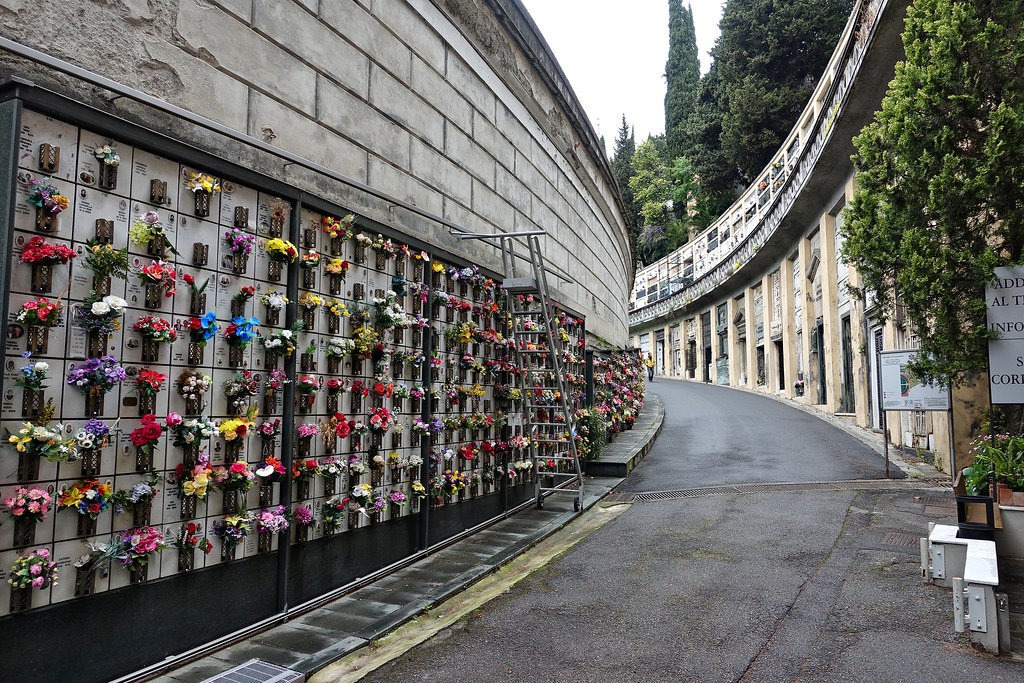  There is something about that graceful Japanese maple that seems perfectly suited to this space ~ 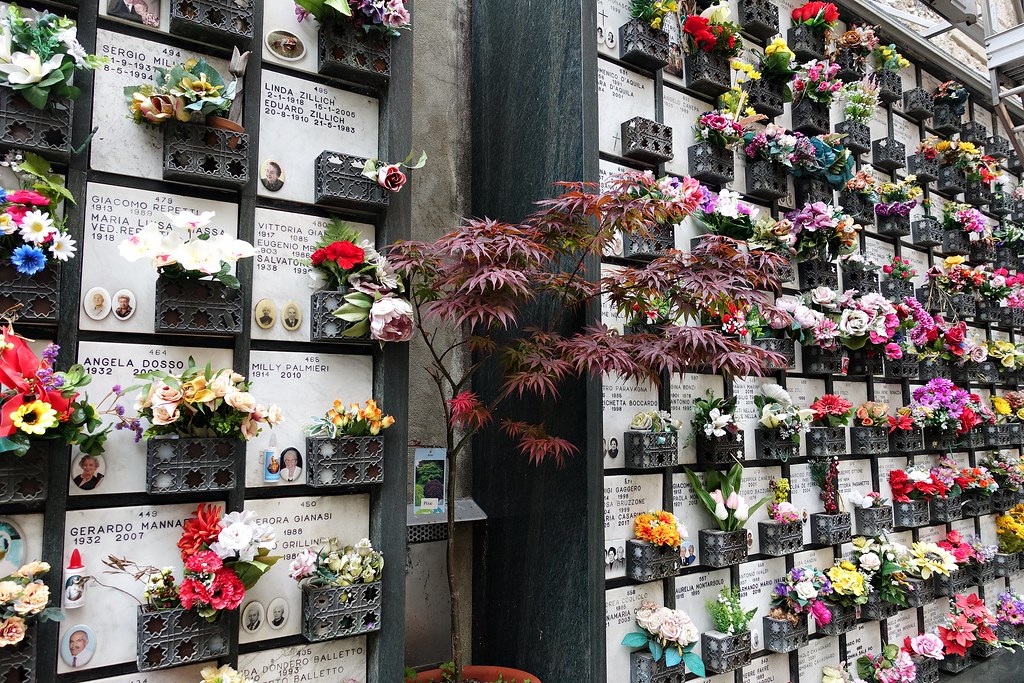 Ooo -- what's that?! As soon as I saw that Gothic confection within the treetops, I became determined to see it up close ~  I was a little reluctant to follow on past this sign, not wanting to provoke the inevitable sad response to tiny little graves ~ 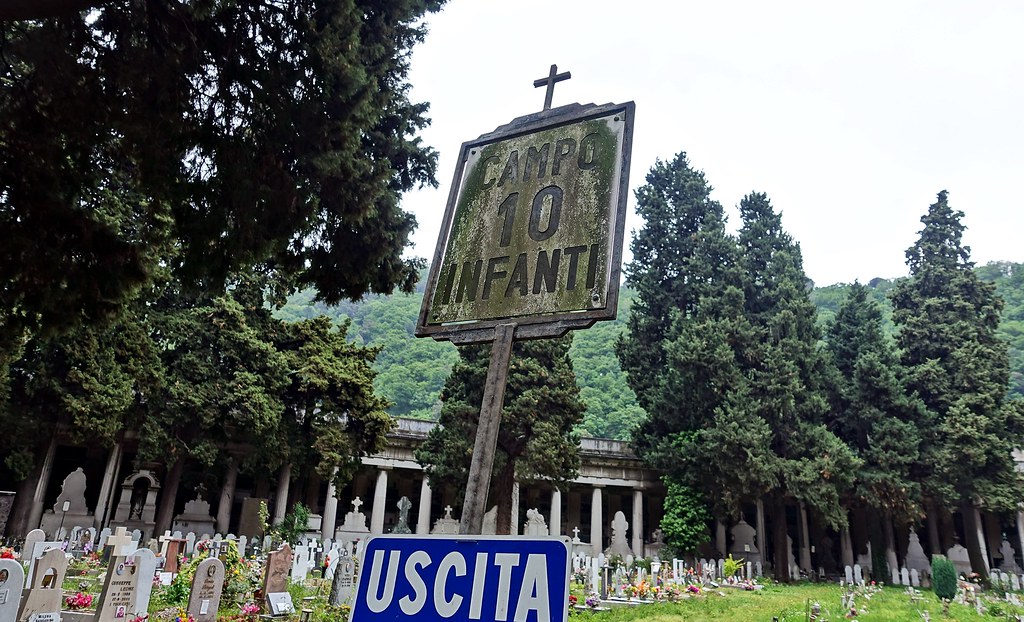 What a shock! I can't claim to have covered every inch of the cemetery, but in the rather large amount I saw, this was the only really neglected area ~ 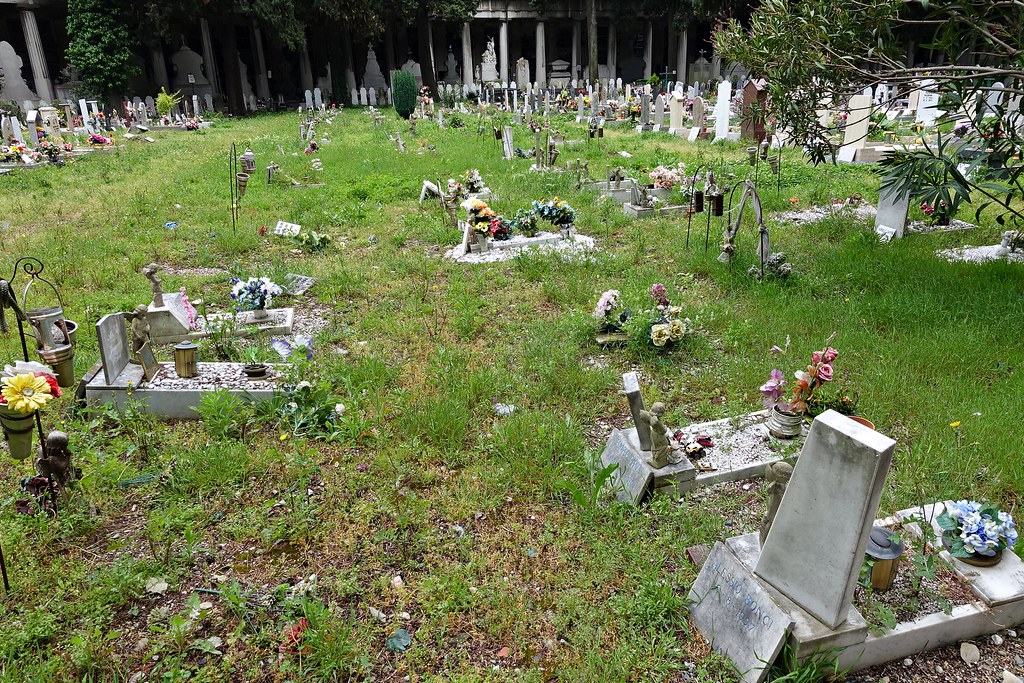 Nearby, an area showing rampant growth from all the rain is still getting loving attention ~ 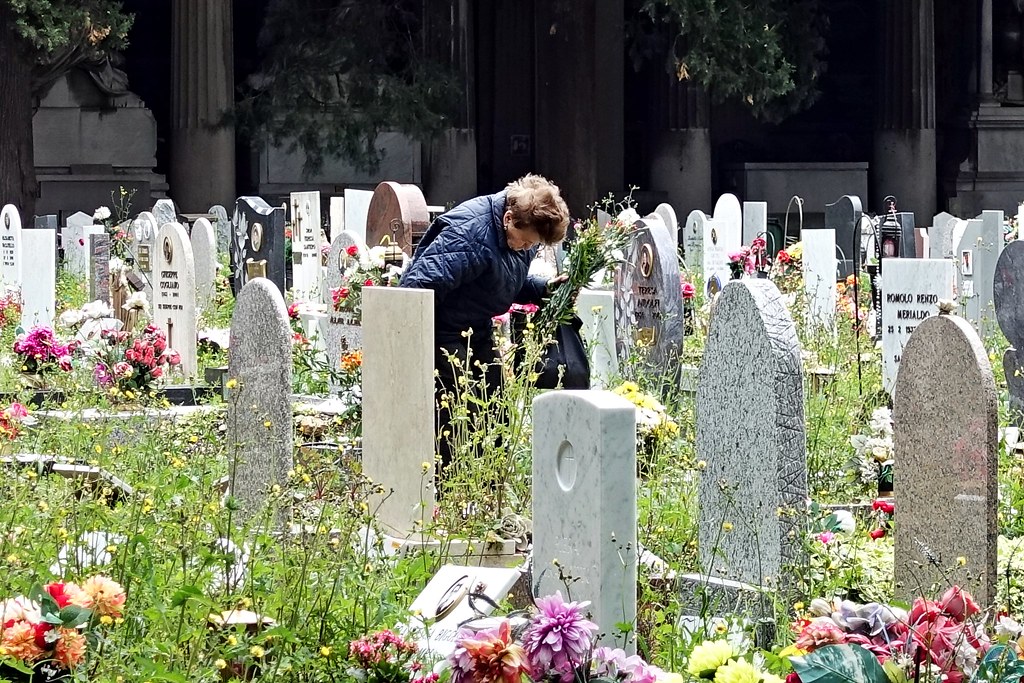 An azalea gives its all next to a patriotic commemoration ~ 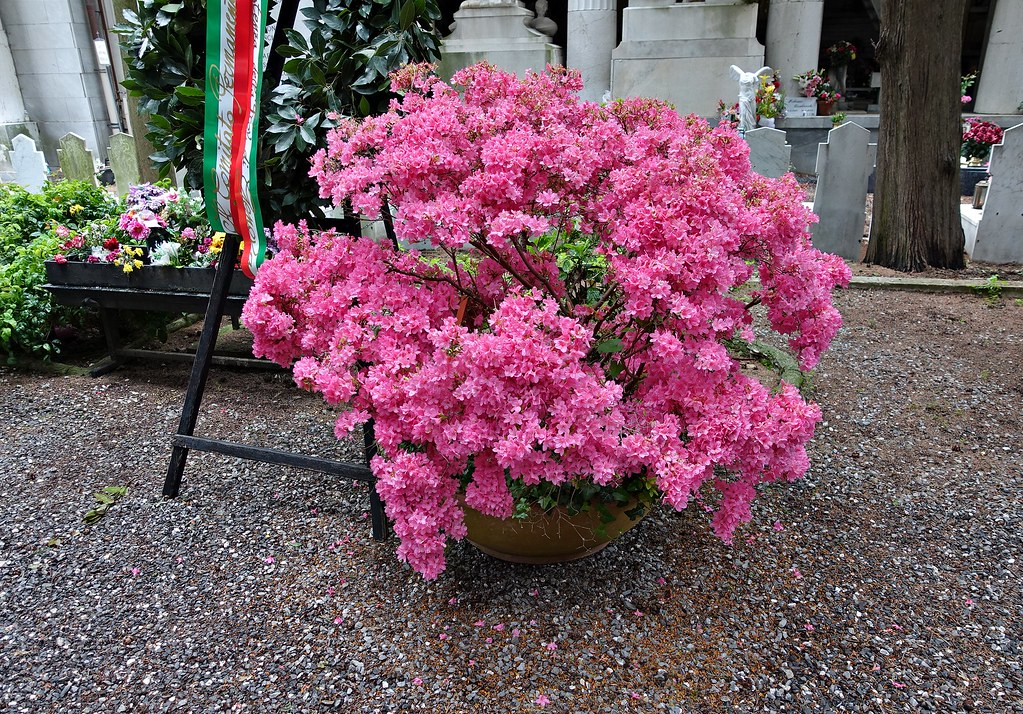 In the part of the US where I'm from, it's quite common to see Italian surnames on graves. I suppose that's why it took a moment or so for it to sink into my consciousness that, oh yes, these were "the enemy". Here are ranks and ranks of carved stones reminding us of the sad stupidity and waste of war ~ |
|
|
|
Post by bixaorellana on Oct 13, 2019 4:43:20 GMT
|
|
|
|
Post by bixaorellana on Oct 13, 2019 4:52:33 GMT
|
|
|
|
Post by kerouac2 on Oct 13, 2019 11:51:55 GMT
Of course now the question is how did the cemetery expand over the years? Did they start at the bottom or the top? Or was the top always for the rich and the little graves at the bottom for the poor? In which case where does the grand covered building fit in? And then there is the columbarium... since the Catholic church only permitted cremation starting in 1963, it looks like they converted some of the shelves meant for coffins into niches for urns.
In any case, the pictures are sensational.
|
|
|
|
Post by lugg on Oct 13, 2019 18:12:15 GMT
Completely agree with K2 your photos are sensational Bixa. It appears to be huge - is there still space for more recent burial's other than in family plots ? I was surprised at how neglected the area for children appears and wondered if maybe they are children who died many years ago ?
|
|
|
|
Post by lagatta on Oct 13, 2019 19:40:17 GMT
|
|
|
|
Post by bixaorellana on Oct 13, 2019 21:53:24 GMT
how did the cemetery expand over the years? ... And then there is the columbarium...is there still space for more recent burial's other than in family plots ? I was surprised at how neglected the area for children appears and wondered if maybe they are children who died many years ago ? Thank you both for the lovely compliments. I'll answer your questions together, if I may, starting from the last & working back. Lugg, I visited in May and there had been a great deal of rain in that area. So sure, lots of spring growth. But as you can see in the picture right after the children's section, other areas just looked overgrown, not neglected. The children's part is so tumbled-down looking, though. I believe I did look at a couple of the plots and none were from the distant past. As far as I can tell, all graves appear to automatically get a wrought-iron arch with a hanging vase. You can see this in Reply #1, in the first and the fifth pictures where there are new graves. Apparently over time families often replace those arches with stone memorials. My guess is that most children would be buried in a family plot and that perhaps poorer or maybe more itinerant people would have the campo infanti as their only option, so possibly there is no one left around to tend those little graves. As far as more space, somewhere in one of the references I checked for this thread, I remember seeing that the cemetery has grown beyond the square kilometer size usually cited. Also, if you wish to check out any of the links I'll post at the end of this report, you'll quickly realize that despite all the pictures I've shown and all the ground I covered, that there is a great deal I never saw. Again, in the fifth picture in Reply #1, you can see very recent burials, so the short answer would be yes, there seems to be space for more burials. Good point about cremation, Kerouac. However a city the size of Genoa, especially since it's a port city with people from all over, would have a good-sized non-Catholic population. If you look closely at the urn stones in the picture, you can see that the oldest dates are from the 1980s. I am guessing from the curved wall that this was a later, clever design to maximize space while still appropriately honoring the cremated dead. It's larger than the pictures indicate, as you'll see later when I show photos taken from above. As far as how the cemetery expanded, it was a planned space from the beginning. The original project was approved in 1835, with the site chosen both because it was sparsely populated and because it fit into the overall vision of a group of galleries opening into a graveyard and grandly mounting in stages up the side of the hill. Work began in 1844 and the cemetery was opened on January 2, 1851, on which day there were four burials. Over time there have been several extensions and there are now sections for British, Jewish, and Protestant burials. Note that I'm cribbing this information and suspect there might be more scholarly and/or references in Italian with better information.
|
|
|
|
Post by bixaorellana on Oct 14, 2019 3:12:32 GMT
As I wander onward, ever onward, it's easy to imagine I'm somewhere far away, or at least a Hollywood or Las Vegas version of far away. Here I contemplate a southeast Asian temple in the jungle ~ 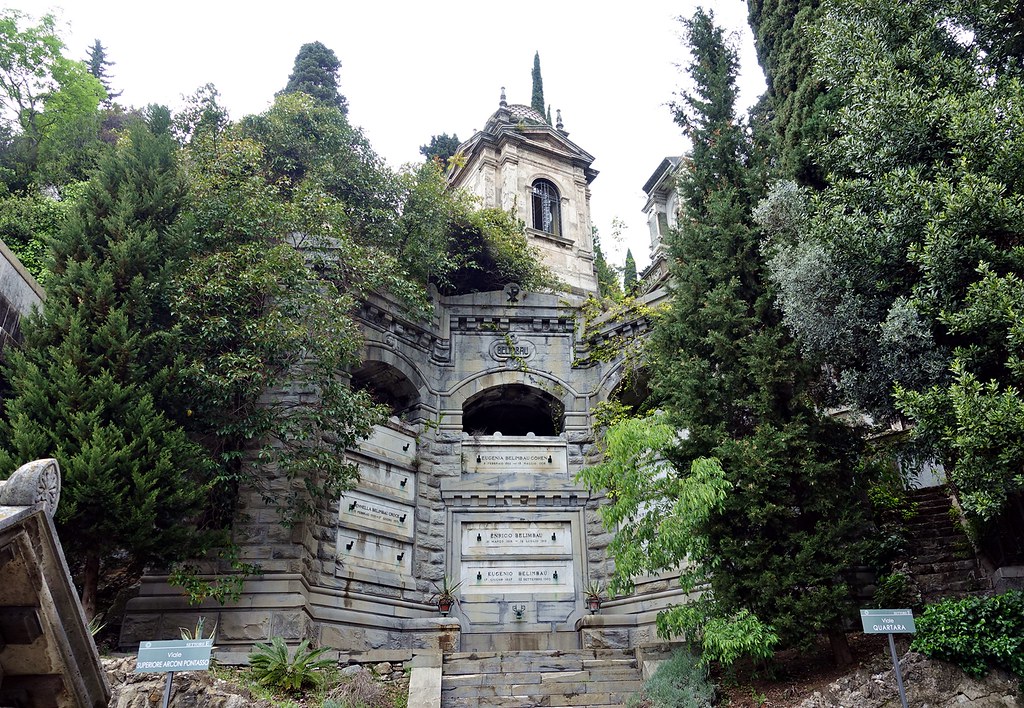 Further on, I encounter a Roman temple, next to a building that is surely from Atlantis ~ 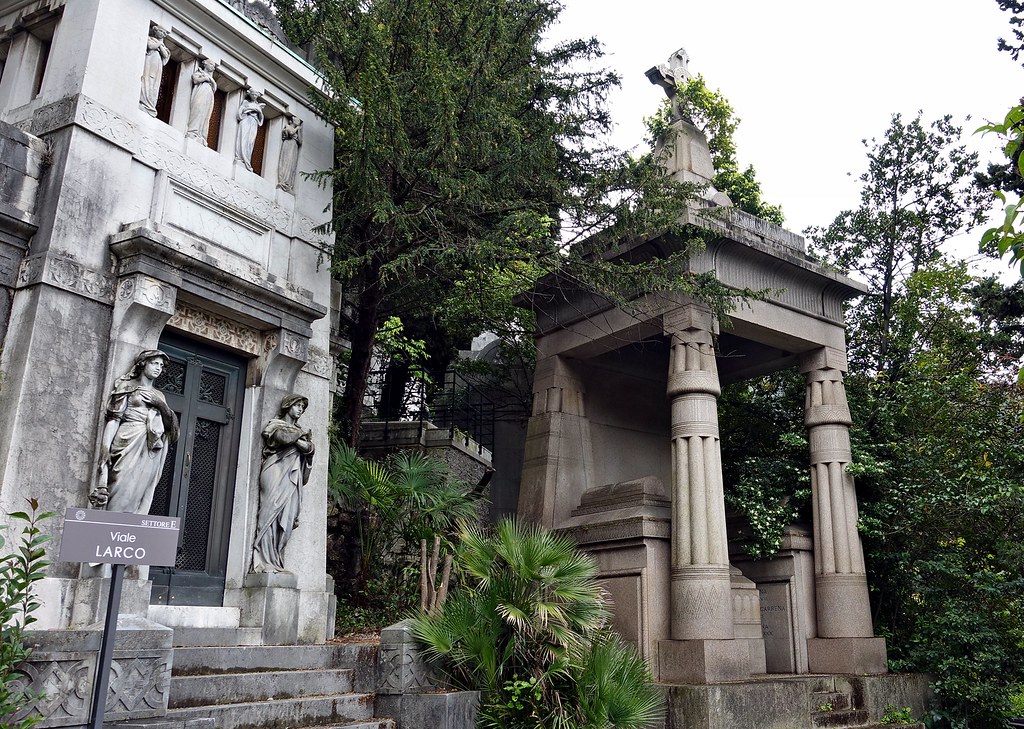 Be still my heart! There is my mini-cathedral goal and I think I see a way to get to it ~  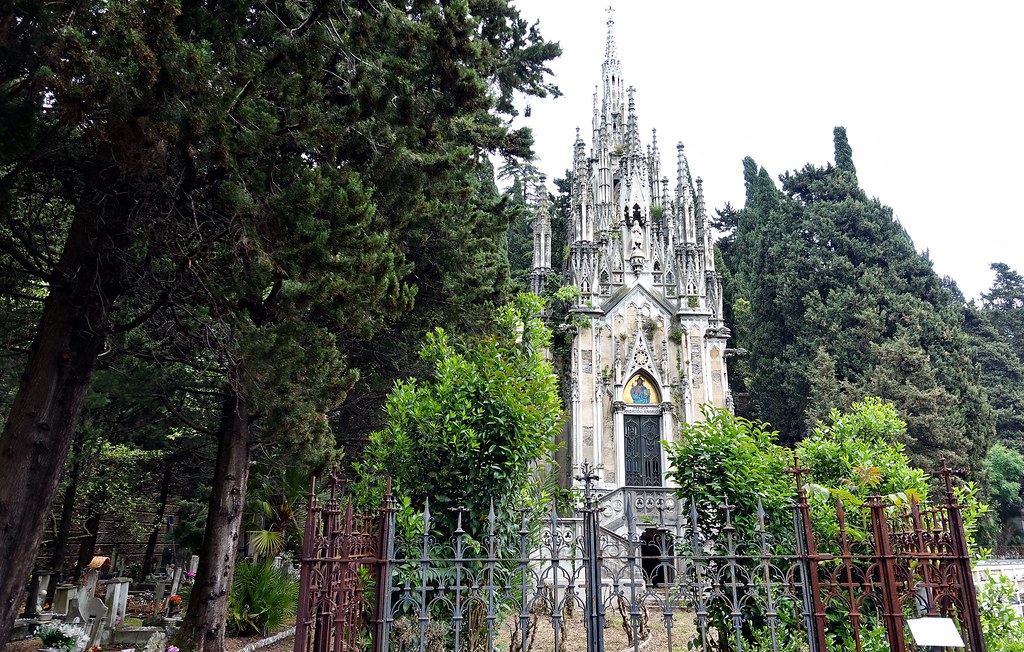 In 1895 the Raggio family got these very nice digs for their eternal rest ~ 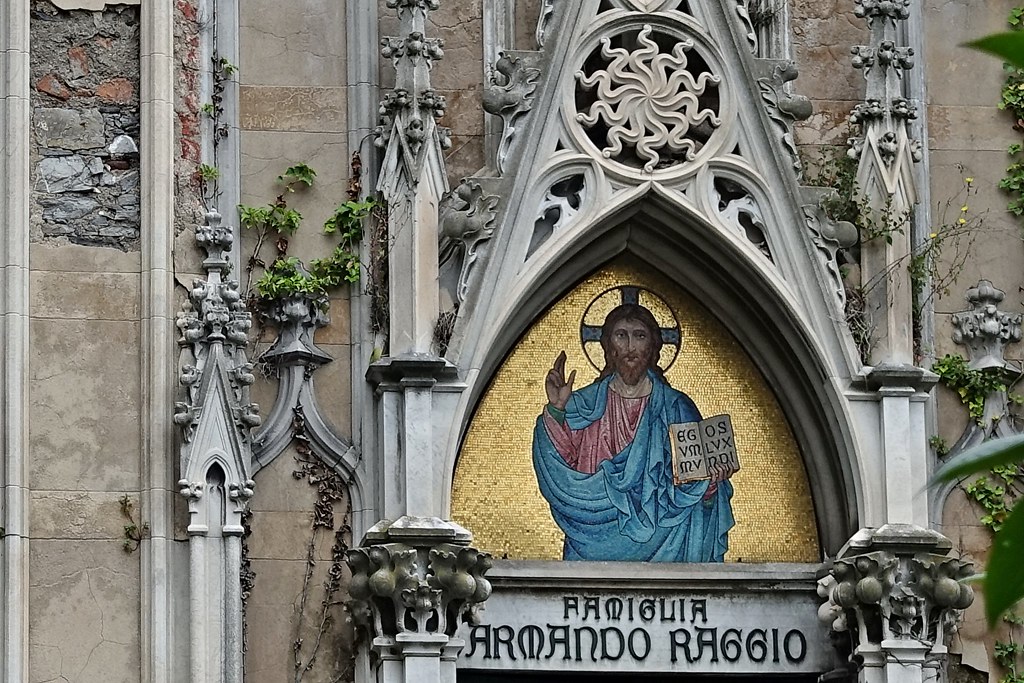 Heading back toward the stairs now, trying to force myself to take fewer pictures ~ 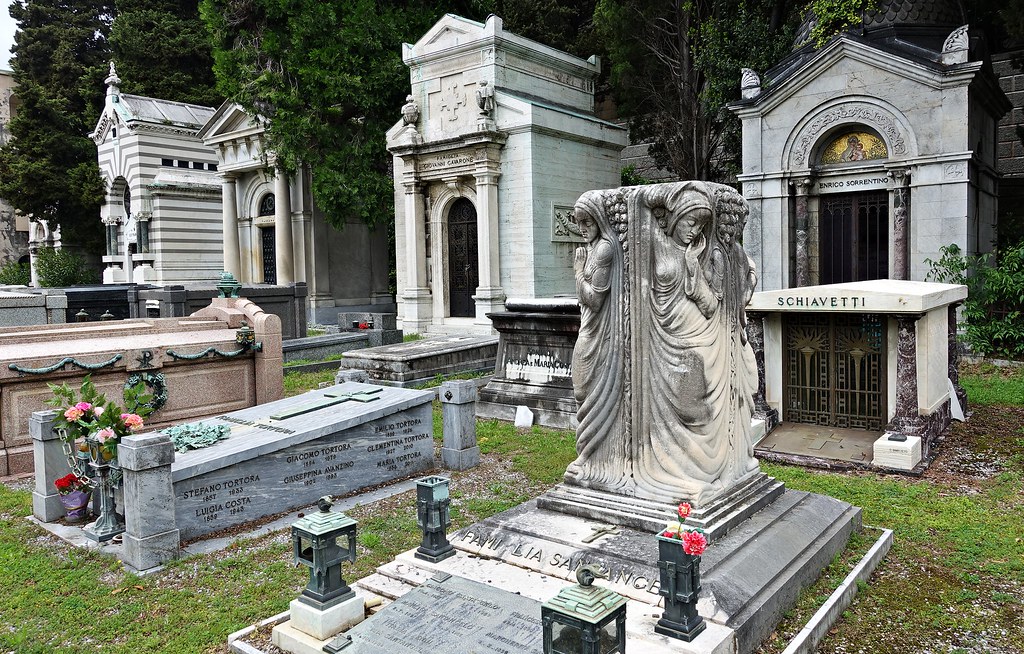 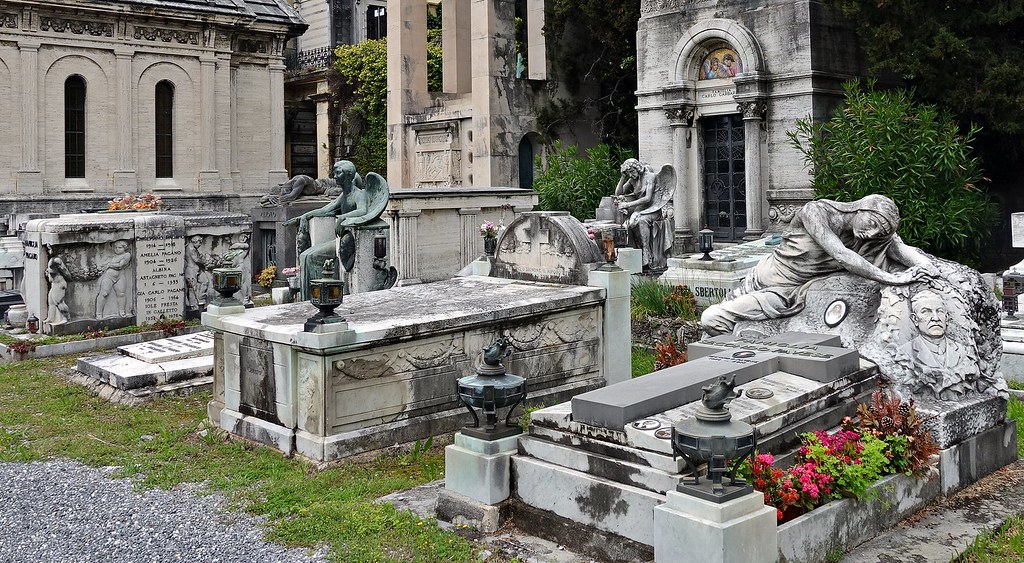 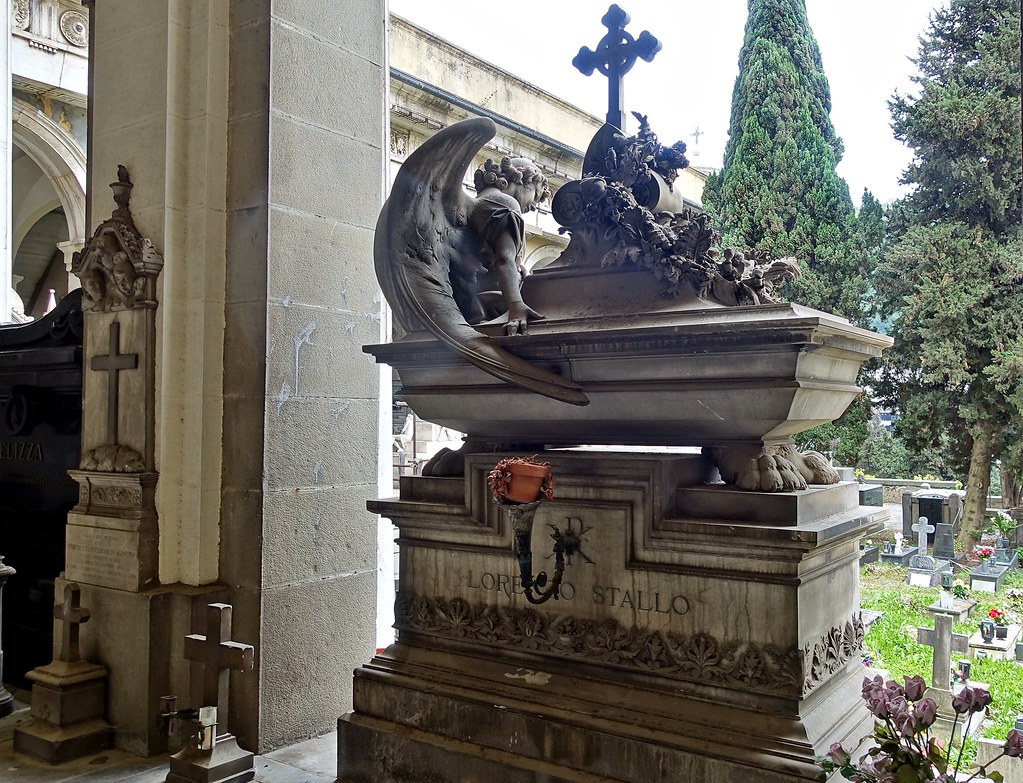 Is this how you all who are following the thread are starting to feel?  Or even like this?  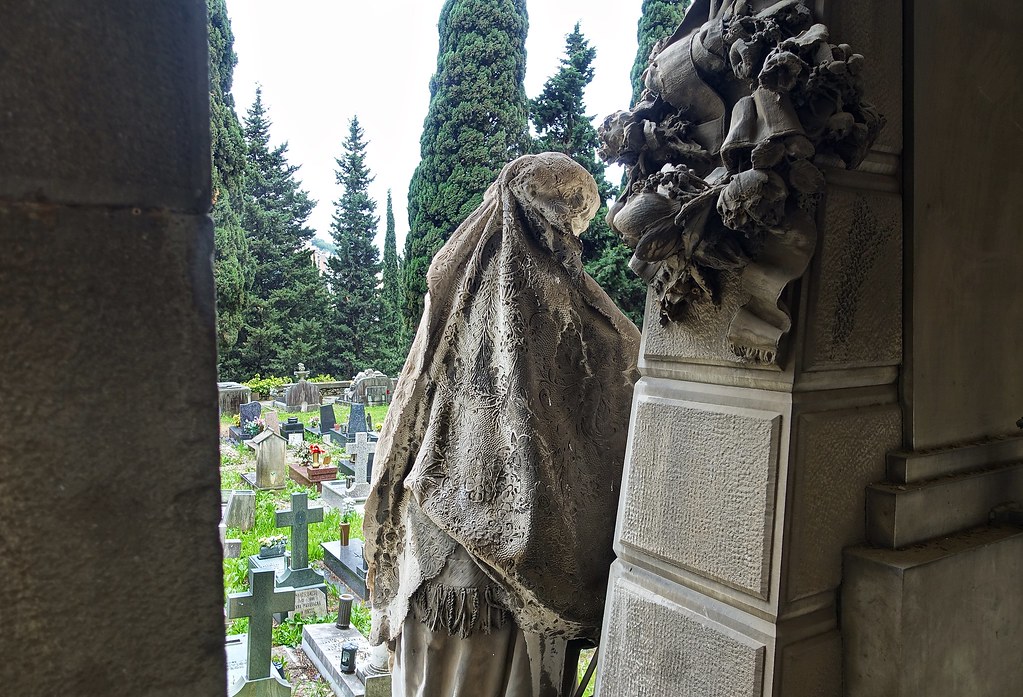 This poor soul has been here for well over a century ...........  ......... gazing upon this and undoubtedly wondering what the hell it's supposed to represent ~ 
|
|
|
|
Post by kerouac2 on Oct 14, 2019 3:26:02 GMT
There is no way to get bored with this thread, but now I am wondering if these tombs were even meant to be visited regularly by the families. Access seems impossibly difficult, so only the younger fitter family members could hope to come and pay their respects, and of course they would be the least motivated ones. Elderly family members such as the widowed spouses would probably be in no condition to ever come unless there is a wagon trail or something that you have not shown us yet.
|
|
|
|
Post by bixaorellana on Oct 14, 2019 4:01:57 GMT
Well, there is that mini bus that runs through the cemetery. I saw one a couple of times when I was on the upper levels and I read something indicating that it has a regular schedule, but I sure can't find more information on that. If you look at the third photo in #21, you can see what a nice road there is. I don't remember seeing any regular cars, but of course I saw almost no vehicles and very few pedestrians. |
|
|
|
Post by bixaorellana on Oct 14, 2019 4:51:14 GMT
|
|
|
|
Post by bjd on Oct 14, 2019 14:01:30 GMT
It is pouring rain outside so a fitting accompaniment to your cemetery pictures. Actually, there wouldn't be so much dust on those statues if they had been left uncovered! Starting at the steps leading up and the graves surrounded by trees reminds me of Père Lachaise Cemetery in Paris. Although there are fewer kitschy tombstones.
|
|
|
|
Post by bixaorellana on Oct 14, 2019 20:35:01 GMT
After I read your remark about the rain being a fitting accompaniment to the cemetery pictures, Bjd, it occurred to me that obviously I've been sitting on these photos since May. My theory is that my sudden need to turn them into a report is because it is October, a time to celebrate the dead in many cultures.  |
|
|
|
Post by fumobici on Oct 14, 2019 21:43:11 GMT
Brava, what a tour de force! The many, carefully framed images make my head whirl, I recoil at times, aestheitically, from what I see, but at the same time I'm drawn in, the sculptural art is commercial but at times masterful. The workmanship is sometimes sublime--there must have been a good school in Genova teaching sculpture, the classic sculptor's challenge is to depict cloth draped over human flesh in a natural way and it is clear these guys (assuming they were guys) had been classicly and ably trained.
There's a lot more going on too, landscaping, gardening, the spaces and geometry of the hillside it is situated on, the sun, the light, roads, paths, a street plan not altogether unlike that of a city plan in miniature. And the spired mirage of the dollhouse cathedral looming above and the labyrithnine, dreamlike (as I imagine in it) quest to reach it up above, I am there with you. It looks pretty well fenced off though once you get there, I'd like to have seen if there were any angles from the near base to frame photos.
|
|
|
|
Post by bixaorellana on Oct 15, 2019 6:00:29 GMT
Oh gosh, Fumobici ~ your artist's attention to this report coupled with your kind words and the fact that you followed in spirit my trek to the mini-cathedral are immensely gratifying and I sincerely thank you. The information about the sculptors is strewn here and there across the internet, but I'll impart here what I have gleaned, just in case it interests anyone. Several sites mention that the tomb statues were created on commission, not surprisingly. I suppose there were books with designs to choose from, with the patrons possibly wanting to put together elements, the way you can pick out clip art to design your own business cards, for better or for worse. I'd say that photos 4 and 5 in reply #12 would seem to show the result of a family committee's wishes. You have to wonder whether the sculptors attempted to apply the aesthetic brakes, or if they spurred the patrons on with ever more elaborate suggestions, which of course would translate to better fees. It probably depended on whether they were artists at heart or not, as of course the finished work would be there forever for everyone to see and judge. At any rate, this segment from the Wikipedia page on funerary art pretty much describes Père Lachaise, Staglieno, and other large cemeteries of the period: By the 19th century, many Old World churchyards and church walls had completely run out of room for new monuments, and cemeteries on the outskirts of cities, towns or villages became the usual place for burials. The rich developed the classical styles of the ancient world for small family tombs, while the rest continued to use gravestones or what were now usually false sarcophagi, placed over a buried coffin. The cemeteries of the large Italian cities are generally accepted to have outdone those of other nations in terms of extravagant statuary, especially the Monumental Cemetery of Staglieno in Genoa, the Cimitero Monumentale di Milano and the Certosa di Bologna. In Italy at least, funerary sculpture remained of equal status to other types during the 19th and early 20th centuries, and was made by the leading artists, often receiving reviews in the press, and being exhibited, perhaps in maquette form.[122]
Monuments kept up with contemporary stylistic developments during the 19th century, embracing Symbolism enthusiastically, but then gradually became detached from the avant-garde after Art Nouveau and a few Art Deco examples.Some of the sculptors represented in Staglieno are: Giovanni Battista TassaraGiulio MonteverdeLeonardo BistolfiEdoardo Alfieri |
|